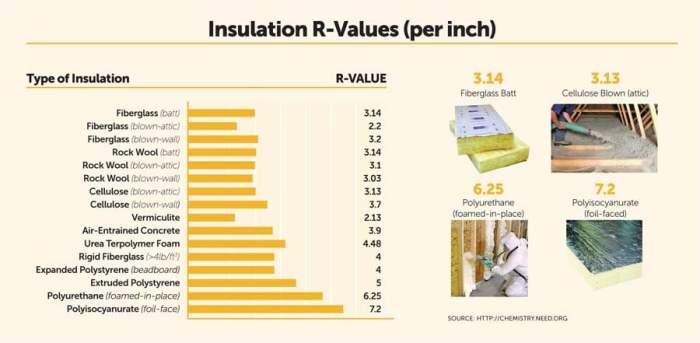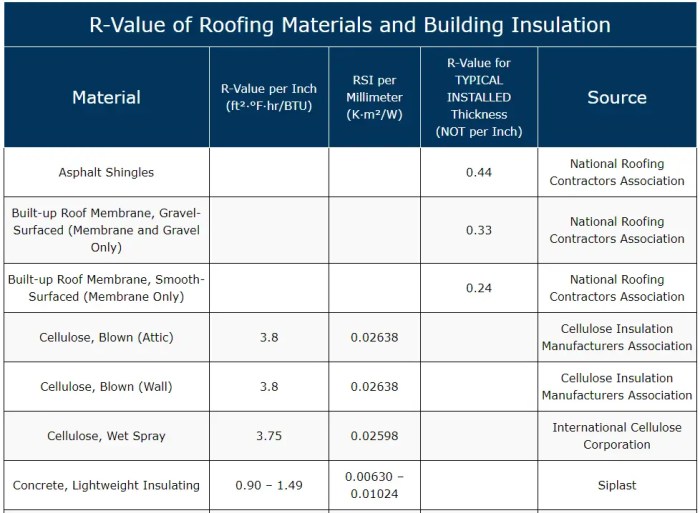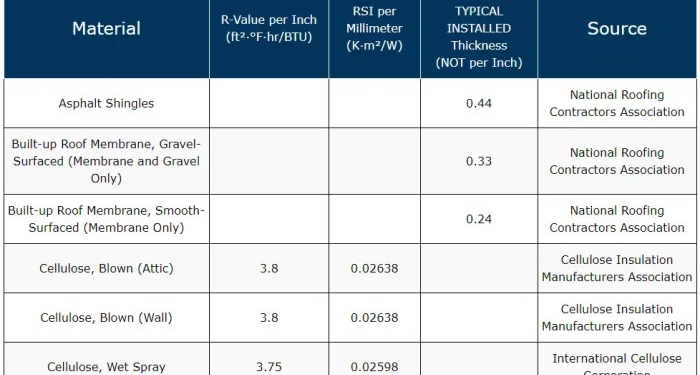Exploring the world of roof insulation materials comparison unveils a realm where knowledge meets practicality. This guide aims to provide a detailed analysis of various insulation materials, offering insights into their characteristics, effectiveness, and suitable applications.
Read on to discover everything you need to know about choosing the right roof insulation materials for your specific needs.
Types of Roof Insulation Materials
Roof insulation materials play a crucial role in maintaining the temperature inside a building and reducing energy costs. There are several common types of roof insulation materials available in the market, each with its own unique characteristics and effectiveness in terms of insulation.
Fiberglass Insulation
Fiberglass insulation is one of the most popular types of roof insulation materials. It is made of tiny glass fibers and is known for its lightweight and easy installation. Fiberglass insulation is also fire-resistant and can effectively reduce heat transfer, making it a suitable choice for both residential and commercial buildings.
Spray Foam Insulation
Spray foam insulation is a versatile material that expands to fill gaps and cracks, providing an airtight seal. It has a high R-value, which measures the material's thermal resistance. Spray foam insulation is ideal for hard-to-reach areas and can help improve the overall energy efficiency of a building.
Reflective Insulation
Reflective insulation works by reflecting heat away from the building, rather than absorbing it. This type of insulation is often used in hot climates to reduce heat gain. Reflective insulation is lightweight and easy to install, making it a cost-effective option for roof insulation.
Cellulose Insulation
Cellulose insulation is made from recycled paper materials treated with fire retardants. It is an eco-friendly option that provides good thermal performance and can help reduce noise transmission. Cellulose insulation is commonly used in attics and walls, offering effective insulation against both heat and cold.
Rigid Foam Insulation
Rigid foam insulation is a dense material that provides excellent thermal resistance. It is moisture-resistant and can be used in various applications, including roofs, walls, and floors. Rigid foam insulation is durable and long-lasting, making it a suitable choice for buildings in harsh weather conditions.
Factors to Consider When Choosing Roof Insulation Materials
When selecting roof insulation materials, several factors need to be taken into account to ensure that the insulation is effective in providing thermal resistance and energy efficiency for your home.
Importance of R-value in Selecting Insulation Materials
The R-value of insulation materials indicates their thermal resistance, which is crucial in determining how well they can prevent heat transfer. Higher R-values signify better insulation properties, so it is essential to choose materials with appropriate R-values based on the climate and energy efficiency goals of your home.
Climate Influence on Material Choice
The climate of the region where your home is located plays a significant role in selecting roof insulation materials. For colder climates, materials with higher R-values are preferred to keep the heat inside during winter. In contrast, for warmer climates, materials with reflective properties or better ventilation might be more suitable to reduce heat gain.
Cost-Effectiveness of Different Materials
While the initial cost of insulation materials is an important consideration, it is also crucial to evaluate their long-term cost-effectiveness. Some materials may have higher upfront costs but offer better energy savings over time, making them a more cost-effective choice in the long run.
Environmental Impact of Insulation Options
When choosing roof insulation materials, it is essential to consider their environmental impact. Some materials are more sustainable and eco-friendly than others, such as recycled insulation or natural fibers. By opting for insulation materials with a lower environmental footprint, you can contribute to reducing your home's overall carbon footprint and environmental impact.
Installation Process for Roof Insulation Materials
When it comes to installing roof insulation materials, it is crucial to follow the correct steps to ensure maximum efficiency and effectiveness. Proper installation not only helps in maintaining the desired temperature inside your home but also contributes to energy savings.
Here are the general steps involved in installing roof insulation materials:
General Steps for Installation
- Start by measuring the area of your roof to determine how much insulation material you will need.
- Clean the roof surface of any debris or dust before installing the insulation.
- Cut the insulation material to fit the specific dimensions of your roof and ensure a proper seal.
- Install the insulation material according to the manufacturer's instructions, whether it's batts, rolls, or rigid foam boards.
- Seal any gaps or seams to prevent air leakage and ensure maximum insulation efficiency.
- Consider adding a vapor barrier depending on the climate in your area to prevent moisture buildup.
Tips for Proper Installation
- For fiberglass batts, make sure to wear protective gear such as gloves, goggles, and a mask to avoid skin irritation and respiratory issues.
- When installing spray foam insulation, hire a professional to ensure proper application and avoid any health risks associated with improper handling.
- Properly insulate around attic hatches, pipes, and ductwork to prevent heat loss in those areas.
Importance of Proper Ventilation
Proper ventilation is essential when installing roof insulation materials as it helps to prevent moisture buildup and maintain indoor air quality. Without adequate ventilation, trapped moisture can lead to mold and mildew growth, compromising the effectiveness of the insulation.
DIY vs Professional Installation
- DIY installation can be cost-effective but may lack the expertise and precision that professional installers provide.
- Professional installation ensures proper application and can help identify any potential issues with the roof structure that may impact insulation effectiveness.
- Consider the complexity of the insulation material and your comfort level with installation before deciding between DIY and professional installation.
Long-Term Performance and Maintenance of Roof Insulation Materials

When considering roof insulation materials, it is important to assess their long-term performance and maintenance requirements to ensure efficiency and durability.
Expected Lifespan of Common Roof Insulation Materials
Here are the expected lifespans of some common roof insulation materials:
- Fiberglass Insulation: 20-30 years
- Spray Foam Insulation: 30-80 years
- Cellulose Insulation: 20-30 years
- Polyurethane Foam Insulation: 30-50 years
Maintenance Requirements for Each Type of Material
Proper maintenance can help extend the lifespan of roof insulation materials. Here are the maintenance requirements for different types of materials:
- Regularly inspect for moisture buildup or leaks
- Ensure proper ventilation to prevent condensation
- Check for pest infestations and address promptly
Identifying Signs of Damage or Degradation in Insulation
It's essential to be able to identify signs of damage or degradation in roof insulation materials. Look out for:
- Water stains on ceilings or walls
- Increased energy bills due to poor insulation
- Mold or mildew growth
Recommendations for Extending the Longevity of Roof Insulation Materials
To prolong the lifespan of roof insulation materials, consider the following recommendations:
- Regularly inspect and maintain your roof insulation
- Address any issues promptly to prevent further damage
- Ensure proper ventilation and air circulation
Outcome Summary

In conclusion, understanding the nuances of roof insulation materials and their comparison is essential for making informed decisions about your property. With the right information at hand, you can ensure optimal insulation performance and long-term cost savings.
Query Resolution
How does the climate affect the choice of roof insulation materials?
The climate of a region can impact the effectiveness of insulation materials. Colder climates may require materials with higher R-values to provide adequate insulation.
What is the importance of proper ventilation during insulation installation?
Proper ventilation is crucial to prevent moisture buildup and ensure the longevity of insulation materials. It helps maintain a healthy indoor environment and prevents issues like mold growth.
How can signs of damage or degradation in insulation be identified?
Signs of damage in insulation materials can include increased energy bills, drafts, and uneven temperatures in the building. Visual inspections and energy audits can help identify such issues.
















